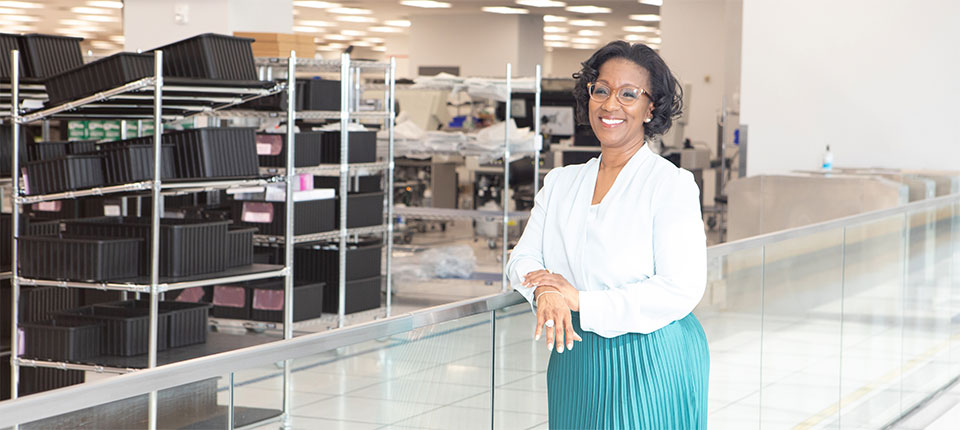Apr. 27, 2022

Many Skills Can Translate into Healthcare Careers
Two engineers describe how they shifted from the aerospace and automotive industries to successful roles at Abbott
- Copy Link
- Share on X
- Share on Facebook
- Share on Linkedin
Many job seekers may ask themselves: Is it possible to move from other industries into healthcare? What does it take to make the transition?
People working across Abbott have made the shift into careers here from other industries, discovering that while the pivot can be challenging, the move is worth the effort.
One of those employees is Ursula Christian, Ph.D., divisional vice president of research and development, hematology for Abbott’s Diagnostics division in Santa Clara, California.
Ursula began her career in aerospace engineering at Lockheed Martin, where she rose in the ranks of engineering technical leadership and spearheaded improvement efforts for projects like combat aircraft build processes. She also worked in software engineering in telecommunications at Motorola.
Engineering as the Vehicle for Science
The unexpected chance to embrace a new industry at Abbott aligned with shifts in Ursula’s personal life and a personal calling.
“I wasn’t really thinking about a career change, but Abbott offered me an opportunity to start a system engineering organization, and that really appealed to me,” Ursula says.
“I'm a change agent, and I was looking to do something more meaningful. My parents were aging, and I was interested in the diagnostic tools used in their healthcare. I didn't know Abbott as an engineering company, but I quickly learned that engineering is the vehicle for the company’s science. Moving to Abbott was a great opportunity to contribute my expertise and integrate engineering and science.”
That’s exactly what Ursula is doing at Abbott as she leads her team in product development for Abbott’s Alinity hq and Alinity hs blood analyzers. Her team harnesses field intelligence to meet the future needs of labs, hospitals, and universities globally.
From Car Brakes to Heart Failure Monitoring
Sam MacNaughton, a senior electrical engineer at Abbott, leads a rewarding career that’s taken him from the academic world to the automotive industry – and now to developing medical devices.
“The throughline for my career has been in developing sensing technologies,” he says. “I work on Abbott’s CardioMEMs devices that sense pressure changes in the pulmonary artery. Our devices can help people with heart failure and their doctors monitor their hearts with the goal of keeping them out of the hospital.”
Before joining Abbott, Sam worked on technologies that sense the pressure in automobile brakes. He was in the automotive industry for the better part of a decade, and then decided to broaden his horizons.
“Working in healthcare, we make a device and that supports somebody with heart failure,” he says. “In electrical engineering terms, that's a tight control loop. That feedback comes quickly. It's an exciting and gratifying place to be.”
Sam says many of the key behaviors that drive success in any industry are similar to the skills needed to make the move into healthcare.
“We're looking for people who are data driven, who can lead and work within cross-functional teams, who are effective communicators,” Sam says. “That's all the same. Similarly, the challenges of working in a product development world with limited resources, compressed timelines, and sometimes communication gaps – those are the same, too.”
While Sam experienced a learning curve around the nuances of industry terminology and FDA approval processes, he says that the medical device industry has an advantage to onboarding people from different industries because of its emphasis on training. Sam received a customized training curriculum on the design controls and processes of the CardioMEMS quality system. That helped him get up to speed quickly and built his confidence to work with core engineering projects.
At Abbott, he found new avenues for professional growth that have inspired him to see his career in a fresh light.
“One of Abbott’s guiding principles is inclusivity,” Sam says. “Inputs from a diverse set of people lead to better outputs, and it’s the same for somebody in their career. I wouldn't pass up the opportunity to gain a new perspective.”
Indications and Important Safety Information:
Visit CardioMEMS HF System for U.S. important safety information.
Leveraging Lessons from Aerospace
Although moving into diagnostics development was a major change for Ursula, she had previously transitioned from aerospace defense into telecommunications. That experience built her confidence and taught her how to move into another industry.
“Instead of being granular about the specifics of an industry, we need to take a broader view,” she says. “We can apply concepts and approaches like system engineering, integration, and program planning to any problem space. These concepts are industry-, product-, and platform-agnostic.”
Based on her experiences, Ursula has key insights for others who switch industries. She says career shifts can leave people feeling vulnerable because they’re leaving the familiar and stepping into a new world with new leaders. Her advice:
- Know the value you bring. You were chosen for a reason. When you are confident in your abilities, you can translate that into the new environment you’re entering.
- Listen and learn. If things are unfamiliar, there's a reason. Try to understand the environment and the culture. You don't try to make one industry like the other. You integrate the best practices of each and create a hybrid.
- Be yourself, transparent, and authentic. If you are very technical, don’t lose that and try to be somebody else. Adapt to the environment while preserving who you are.
- Allow yourself to be vulnerable and own your mistakes.
For the latest on Abbott’s life-changing technology, get updates directly in your inbox.